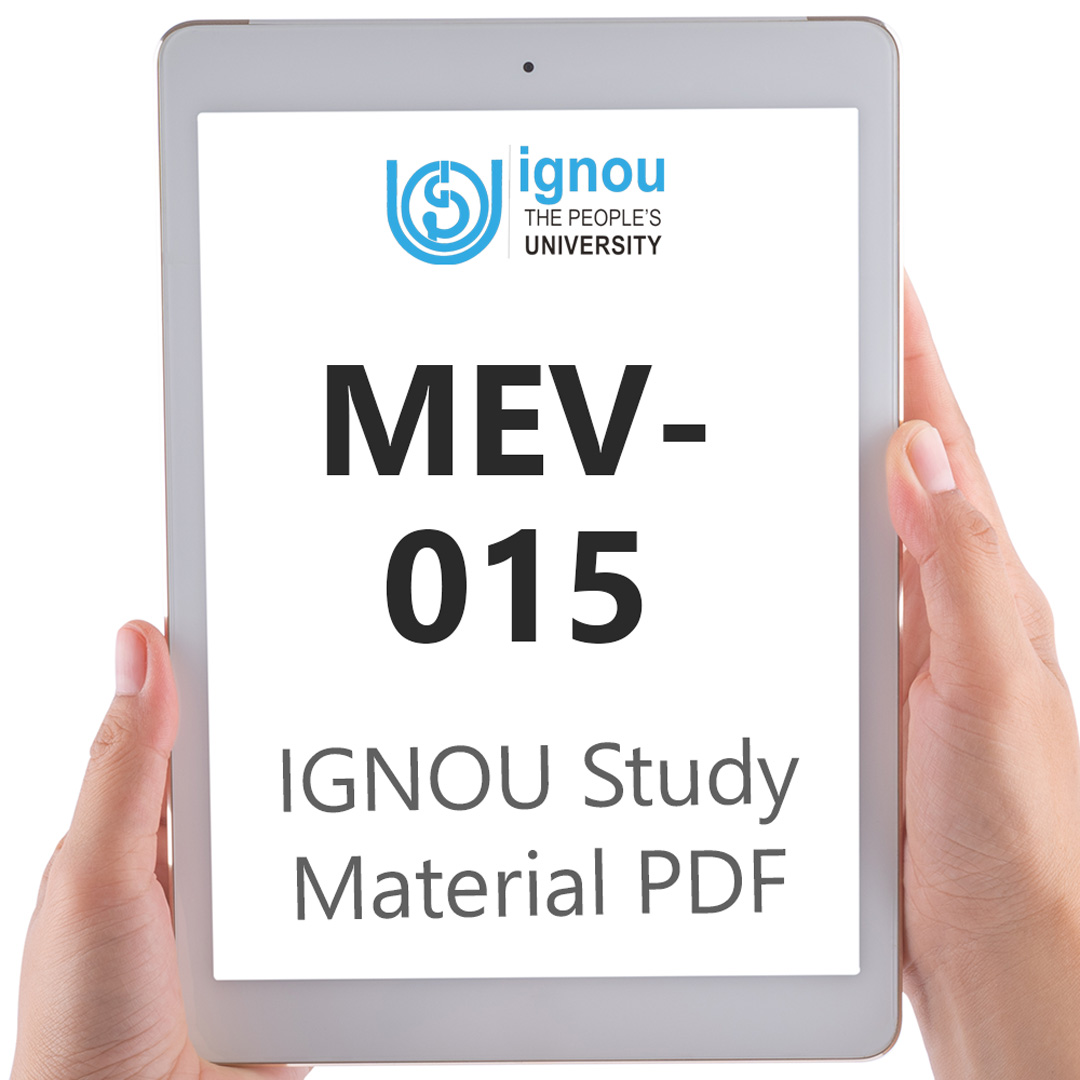If you are looking for MEV-015 IGNOU Solved Assignment solution for the subject Environmental Pollution, Control and Management, you have come to the right place. MEV-015 solution on this page applies to 2023-24 session students studying in MSCENV, MAEVS, PGDEVS courses of IGNOU.
MEV-015 Solved Assignment Solution by Gyaniversity
Assignment Code: MEV-015/TMA-01/ January 2023 to July 2024 session
Course Code: MEV-015
Assignment Name: Environmental pollution, Control and Management
Year: 2023-2024
Verification Status: Verified by Professor
Q1) Name and describe any three control devices for the control of particulate emissions.
Ans) The use of control devices for the management of particulate emissions, which are defined as fine particles and dust that are discharged into the air, is essential for the purpose of preserving air quality and minimising the negative effects on both human health and the environment. Here are three control devices that are commonly used: Fabric Filter (Baghouse Filter), Electrostatic Precipitator (ESP), and Cyclone Separator are the three separate devices.
a) Electrostatic Precipitator (ESP):
1) Description: An Electrostatic Precipitator is a sophisticated piece of equipment for controlling particulate matter that employs an electrostatic charge in order to isolate particles from exhaust gases. In its construction, it is made up of a number of parallel plates or tubes that are charged with electricity. The particles acquire a negative charge as they travel through the exhaust flow that contains particulates and are then passed through the ESP machine. The positively charged plates or tubes attract and collect the charged particles, which effectively removes them from the gas stream. This is accomplished by removing the particles from the gas stream.
2) Application: In order to manage particulate emissions, such as fine dust and ash, environmental control systems (ESPs) are utilised extensively in power plants, industrial boilers, and cement kilns.
b) Fabric Filter (Baghouse Filter):
1) Description: A Fabric Filter, often referred to as a baghouse, is a type of filtering device that is utilised to collect particulate matter by the utilisation of fabric sleeves or tubes. As the tainted gas travels through the fabric, the particulates are dragged to the surface of the filter, where they remain trapped. Reverse air flow, mechanical shaking, and pulse jet cleaning are some of the methods that are used to clean the bags on a regular basis. These processes dislodge and collect the collected particulates in a hopper for disposal.
2) Application: In order to remove fine particles and pollutants such as dust, fumes, and fine powders, baghouses are utilised in a variety of industries, including the processing of metals, the pharmaceutical industry, and the food processing industry.
c) Cyclone Separator:
1) Description: In order to separate particle matter from a gas stream, a cyclone separator is a mechanical device that is not only straightforward but also highly effective. Specifically, it is a chamber that is either cylindrical or conical in shape, with an inlet located near the top and an outlet located at the bottom. A whirling motion is produced as a result of the introduction of the gas stream in a tangential direction at a high velocity. Because of the force of centrifugation, the heavier particulate matter is compelled to travel towards the walls of the cyclone, where it gathers at the bottom of the device. Meanwhile, the gas that has been cleaned is expelled through the top of the device.
2) Application: In many different industries, cyclone separators are frequently utilised as pre-filters. This is especially true in the woodworking and grain processing industries, as well as in larger systems, where they serve as the primary step of particulate control.
Q2) Explain inversion. Elaborate on how inversion will affect the dispersion of pollutants
Ans) Definition of Inversion:
An inversion is a meteorological phenomenon characterized by the reversal of the normal temperature gradient in the atmosphere. Typically, the Earth's atmosphere exhibits a decrease in temperature with increasing altitude, which is known as a "temperature lapse rate." However, during an inversion, this lapse rate is inverted, resulting in a layer of warmer air trapped above a layer of cooler air near the Earth's surface. This warm air acts as a lid or cap, preventing the vertical mixing of air masses.
Effects of Inversion on the Dispersion of Pollutants
Inversions can have significant impacts on the dispersion of air pollutants, and these effects are largely unfavourable. Here's how an inversion affects pollutant dispersion:
a) Temperature Trapping: In an inversion, the layer of warmer air acts as a barrier, preventing the upward movement of air. This means that air near the surface, along with any pollutants it contains, becomes trapped beneath the inversion layer. The vertical dispersion of pollutants is severely limited.
b) Reduced Vertical Mixing: Under normal conditions, vertical mixing occurs as warm air rises, carrying pollutants with it and allowing for the dilution and dispersal of pollutants. Inversions hinder this vertical mixing, as warm air near the surface cannot rise through the inversion layer.
c) Pollutant Concentration Increase: As pollutants remain trapped near the surface, their concentrations tend to increase. This can result in poor air quality, as pollutants accumulate and become more concentrated in the lower atmosphere.
d) Visibility Reduction: Inversions often lead to the accumulation of fine particulate matter and pollutants, which can reduce visibility and create smog, haze, or fog in affected areas.
e) Health Impacts: Poor air quality resulting from inversion conditions can have adverse health effects on humans. Increased concentrations of pollutants like ground-level ozone, particulate matter, and carbon monoxide can exacerbate respiratory problems and lead to health issues.
f) Environmental Impact: Inversions can have negative effects on the environment. High pollutant concentrations can harm ecosystems, damage vegetation, and contribute to acid rain formation.
g) Temperature Changes: The temperature inversion itself can affect weather patterns. Warmer air aloft can suppress cloud formation and precipitation, leading to dry and stable conditions. This can exacerbate the effects of droughts in regions experiencing inversion events.
h) Long-Range Transport: Inversions can influence the transport of pollutants over long distances. Instead of being dispersed vertically, pollutants may spread horizontally, affecting areas downwind of the source.
It's important to note that inversions are not uniform and can vary in intensity, duration, and altitude. Shallow inversions may have milder effects, while deep, persistent inversions can lead to severe air quality problems. Urban areas and valleys are often more susceptible to inversion events due to local topography and the presence of pollution sources. Efforts to mitigate the impact of inversions on pollutant dispersion include reducing emissions from local sources, implementing air quality monitoring and early warning systems, and promoting public awareness about air quality and health precautions during inversion events. Additionally, weather forecasting and meteorological data can help communities prepare for and respond to inversion conditions to protect both human health and the environment.
Q3) Discuss any two aerobic methods available for sludge treatment
Ans) Aerobic methods for sludge treatment are processes that involve the use of oxygen to facilitate the decomposition of organic matter in sewage sludge. These methods are commonly employed in wastewater treatment facilities to reduce the volume of sludge, eliminate pathogens, and stabilize the sludge for safe disposal or beneficial reuse. Two key aerobic methods for sludge treatment are aerobic digestion and composting.
a) Aerobic Digestion: Aerobic digestion is a biological treatment process that relies on the introduction of air or oxygen into the sludge to support the activity of aerobic microorganisms (bacteria and fungi) responsible for breaking down organic matter. This process occurs in specially designed tanks or basins known as aerobic digesters.
Here's how aerobic digestion works and its key features:
1) Process Description: In aerobic digesters, sewage sludge is mixed with oxygen to create an aerobic environment. Aerobic microorganisms naturally present in the sludge or introduced are responsible for biodegrading the organic components of the sludge.
2) Oxygen Supply: Oxygen is supplied through mechanical aeration, which can involve the injection of air or pure oxygen into the sludge, or surface aeration, where air is mixed into the sludge through mechanical means like surface impellers.
3) Temperature and pH Control: To optimize microbial activity, the temperature and pH of the sludge are controlled within specific ranges. Typically, temperatures between 20°C and 37°C (68°F to 98.6°F) and a neutral to slightly alkaline pH range are maintained.
4) Solids Reduction: During the aerobic digestion process, organic matter is biologically converted into carbon dioxide, water, and microbial biomass. As a result, the sludge volume is reduced, and the sludge becomes less odorous and more stable.
5) Pathogen Reduction: Aerobic digestion also contributes to the reduction of pathogens in the sludge, making it safer for further disposal or reuse.
6) Duration: The duration of aerobic digestion can vary depending on the specific sludge characteristics and treatment goals. It typically ranges from a few days to a few weeks.
b) Composting: Composting is another aerobic treatment method that is particularly suitable for organic-rich sludge, such as sewage sludge with a high content of organic matter. Composting processes involve the controlled decomposition of organic materials into a stable and humus-rich end product.
Here's how composting works and its key features:
1) Process Description: Composting involves mixing sewage sludge with bulking agents such as wood chips, sawdust, or yard waste to improve aeration and porosity.
2) The mixture is then actively aerated by turning or mechanically agitating the compost pile.
3) Oxygen Supply: Aeration is a critical component of composting. It ensures that sufficient oxygen is available for the aerobic microorganisms responsible for decomposing organic matter in the sludge.
4) Temperature and Moisture Control: Composting relies on maintaining specific temperature ranges (typically between 40°C and 70°C or 104°F and 158°F) and moisture content to create an optimal environment for microbial activity.
5) Microbial Activity: Naturally occurring microorganisms, including bacteria and fungi, as well as introduced thermophilic microorganisms, play a key role in breaking down organic matter in the sludge.
6) Solids Reduction and Stabilization: Composting significantly reduces the volume of sewage sludge and transforms it into a stable, humus-rich product known as compost. This end product is less odorous and can be used as a soil conditioner or fertilizer.
7) Pathogen Reduction: The high temperatures achieved during composting contribute to the reduction of pathogens in the sludge, making the composted material safer for land application.
8) Maturation Phase: After the active composting phase, the compost is typically subjected to a maturation phase, where it continues to undergo biological transformations, resulting in a more mature and stable end product.
9) Duration: Composting durations can vary but often range from a few weeks to several months, depending on the specific process design and goals.
Q4) Distinguish between loudness and annoyance
Ans)Comparison between loudness and annoyance:
Q5) Differentiate between activated sludge process and trickling bed filter
Ans) Comparison between activated sludge process and trickling bed filter:








